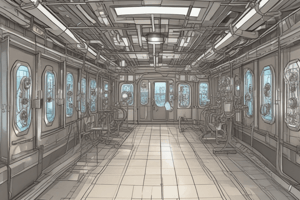Podcast
Questions and Answers
What distinguishes invasive mechanical ventilation from noninvasive ventilation (NIV)?
What distinguishes invasive mechanical ventilation from noninvasive ventilation (NIV)?
- Invasive ventilation uses a face mask, while NIV requires an endotracheal tube.
- Invasive ventilation is only used for short-term respiratory support, while NIV is for long-term.
- Invasive ventilation delivers positive pressure via an endotracheal or tracheostomy tube, while NIV uses a face mask. (correct)
- Invasive ventilation relies on negative pressure, while NIV uses positive pressure.
What is the primary mechanism by which gas exchange occurs during invasive mechanical ventilation?
What is the primary mechanism by which gas exchange occurs during invasive mechanical ventilation?
- Negative pressure draws air into the lungs, facilitating oxygen absorption.
- The ventilator continuously oscillates airway pressure, enhancing gas mixing within the lungs.
- A predetermined mixture of gases is forced into the airways, increasing intra-alveolar pressure and promoting passive expiration. (correct)
- The ventilator actively extracts carbon dioxide from the alveoli, creating a concentration gradient for oxygen diffusion.
In which of the following clinical scenarios would invasive mechanical ventilation be MOST appropriate?
In which of the following clinical scenarios would invasive mechanical ventilation be MOST appropriate?
- A patient with mild dyspnea and a history of COPD.
- A patient with severe respiratory failure and depressed mental status due to a drug overdose. (correct)
- A patient with stable asthma exacerbation responding to nebulizer treatments.
- A patient with mild sleep apnea managed with CPAP at home.
Why is early consideration of invasive mechanical ventilation emphasized, regardless of the specific indication?
Why is early consideration of invasive mechanical ventilation emphasized, regardless of the specific indication?
What determines the end of the inspiratory phase during invasive mechanical ventilation?
What determines the end of the inspiratory phase during invasive mechanical ventilation?
In the context of invasive mechanical ventilation, which of the following best describes the process of expiration?
In the context of invasive mechanical ventilation, which of the following best describes the process of expiration?
Which of the following is a KEY function typically assumed by invasive mechanical ventilation in patients with respiratory failure?
Which of the following is a KEY function typically assumed by invasive mechanical ventilation in patients with respiratory failure?
A patient with variceal bleeding is at increased risk of which complication that may warrant invasive mechanical ventilation?
A patient with variceal bleeding is at increased risk of which complication that may warrant invasive mechanical ventilation?
Flashcards
Invasive Mechanical Ventilation
Invasive Mechanical Ventilation
Delivery of positive pressure to lungs via endotracheal or tracheostomy tube.
Positive Pressure
Positive Pressure
Air is forced into the lungs, increasing intra-alveolar pressure.
Expiration
Expiration
Passive airflow from alveoli to central airways after pressure decreases.
Noninvasive Ventilation (NIV)
Noninvasive Ventilation (NIV)
Signup and view all the flashcards
Indications for Invasive Ventilation
Indications for Invasive Ventilation
Signup and view all the flashcards
Airway Protection
Airway Protection
Signup and view all the flashcards
Respiratory Failure
Respiratory Failure
Signup and view all the flashcards
Early Consideration
Early Consideration
Signup and view all the flashcards
Study Notes
Invasive Mechanical Ventilation: Introduction
- Invasive mechanical ventilation delivers positive pressure to the lungs via an endotracheal or tracheostomy tube.
- Predetermined air mixture (oxygen, other gases) forces air into the alveoli.
- Increasing intra-alveolar pressure, followed by passive expiration, completes the cycle.
- Often used in respiratory failure to replace spontaneous breathing function.
- Also indicated for airway protection, like in cases of altered mental status or variceal bleeding.
- Early initiation is crucial; delaying ventilation until emergent is not recommended.
Modes of Ventilation, Initial Settings, and Supportive Care
- Common ventilation modes and initial settings are discussed separately.
- Supportive care for intubated patients is addressed in the text.
Indications for Invasive Mechanical Ventilation
- Respiratory failure is a primary indication.
- Airway protection (e.g., aspiration risk) is another.
- Examples include depressed mental status, variceal bleeding.
- Prompt initiation is essential; delaying it is not ideal.
- Specific indications, initial settings, and complications are detailed elsewhere
Studying That Suits You
Use AI to generate personalized quizzes and flashcards to suit your learning preferences.



